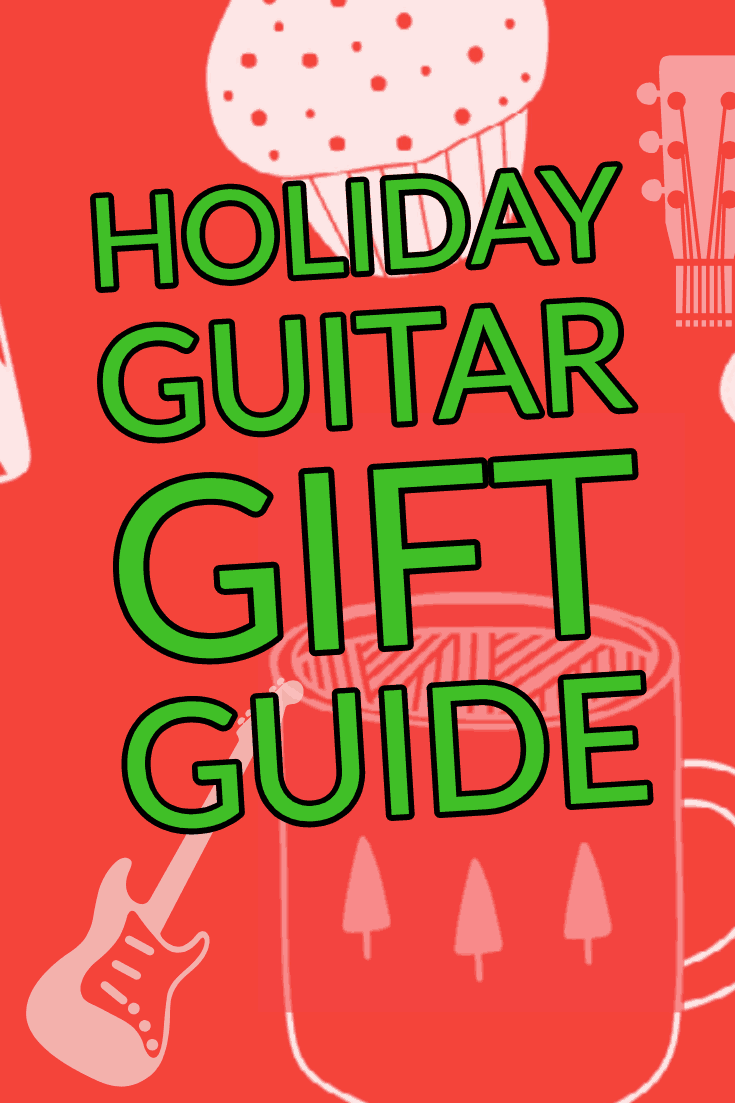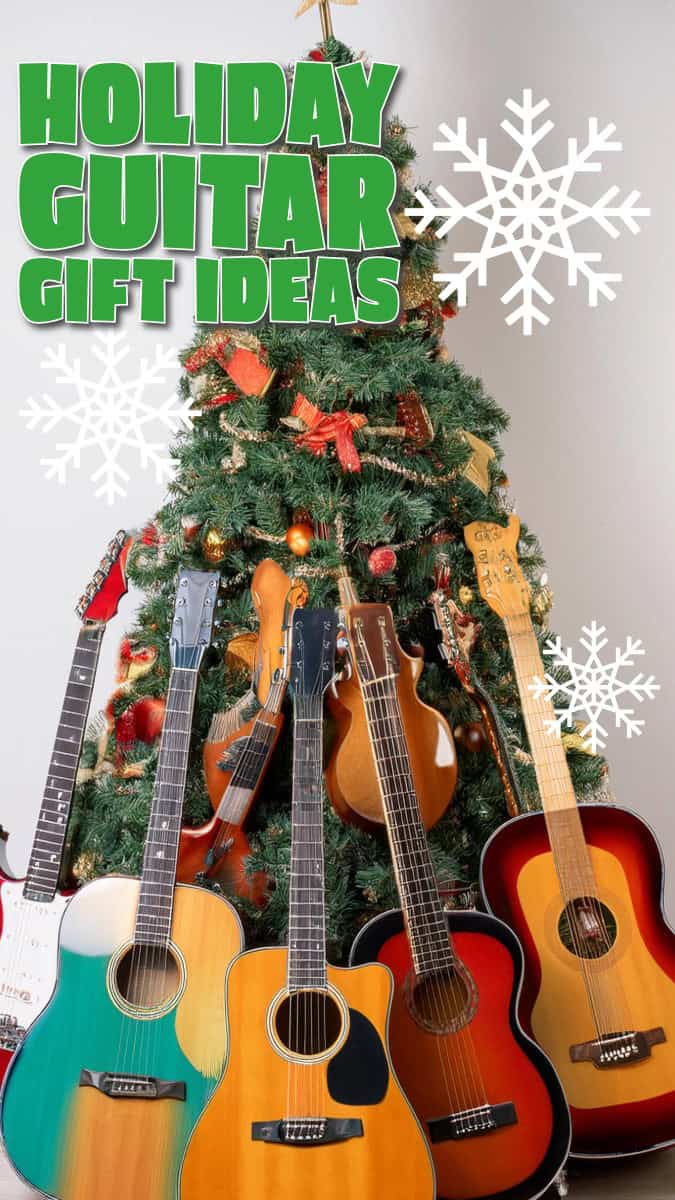As the 2024 Holidays approach, I’ve decided to update my Line 6 HX Stomp Review and accompanying Holiday Guitar Gift Guide. Guitarists and guitar students always ask me what pedals, amps, cables, picks, and stings I’m using. As the Helix Line 6 stuff is still so hot, I’ve also updated my initial review.
In This Article:
Is the Line 6 HX Stomp still viable in 2024 and beyond? We think so. As Thanksgiving and Black Friday approach, we’re all getting ready for our holiday gear shopping, whether for ourselves or the guitarist in your life. If you’re like me, you do most of this shopping online.
At this point in my guitar playing career, I really don’t feel the need to go to a big chain music store and listen to some kid (who let’s face it, doesn’t know as much as I do) demo and talk about the gear I need or use playing guitar 200+ gigs per year.

Guitar Gear Essentials
My biggest hurdle at this point is remembering to buy the monthly necessities like picks and strings before I run out. What follows is my take on the Holiday Guitar Player buyers guide… but with one little twist. This is all gear I actually use and have purchased for myself in the past few years or so.
I get emails from readers regularly asking questions about picks, strings and what amps I’m using live or in videos I’ve posted. Well, here ya go…

This isn’t just a list of random gear to buy. I actually use this stuff on live gigs and in the studio. Endorsements are something I don’t take lightly and I am not now, nor have I have ever been associated with any of the companies listed below.
This stuff and it helps me do my job every day as a full time working guitarist. As a result, I hope that my experience and knowledge with this select list of guitar gear can help someone out there. Enjoy!
Line 6 HX Stomp
As a lifelong tube amp guy, I’ve been fighting the modeling stuff for a while. There was always something missing, whether it was that tube amp warmth and feel, or just that fake sounding high end bite you get from playing through an actual computer.
Since the Tone–X, Kemper and Axe FX models have stepped it up, any discerning tone snob has to take notice these days.
I recently did an acoustic gig with my favorite bass player, Michael Amico (Pat Travers, KGB, Hard Drive) Mike was using the HX Stomp as his bass rig right into the mixing board. He loves it and described it as a stripped down Helix (The $1500+ big brother to the HX Stomp).
I had to give it a try. With some electric gigs coming up with my Rock and Metal cover band so it seemed like the perfect time to put together a new rig. I basically built my entire live rig around the HX Stomp per Mike’s recommendation.

Line 6 HX Stomp Edit Software
The first time I plugged into the HX Stomp, I was a little overwhelmed with the number of features, menus and knobs on this little pedal. The manual is beefy and a little intimidating, but don’t let that scare you.
Once you register your HX Stomp on line6.com you’ll be directed to download the HX Edit software and the Line 6 installer for your Mac or PC. On my 2017 MacBook Pro, the whole process was a breeze. Simply plug the included USB cable from the HX Stomp into your computer and you’re all set.
Is the Line 6 Software Hard To Use?
To say the HX Edit Software is intuitive is an understatement. Hats off to the Line6 folks for making this stuff crazy simple for us musicians who may or may not be software engineers.
The first thing you’ll notice is a list of pedals, effects and amps you can “stack” in any order you want with a simple click. You can also add cabinets, mics and IR’s to simulate a real, live, air-blowing guitar amp. After that, it’s simply a matter of dialing in the tone you want with sliders that act the same as real knobs on real amps and pedals.
The biggest selling point to this thing is, you get the sounds and tech from the Line 6 Helix in a pedal sized box for under $600. The downside is, you can only stack 6 amps, effects and cabs/IRs. Hardly limiting.
Keep in mind, you can use the HX Stomp as a stand alone effects unit into your existing amp without all of the amp and cab sims. It’s super versatile for just about any application you can think of.
Dialing up a Great Guitar Tone with the HX Stomp
I immediately dialed up a great utility rock sound using the “Placater” model, based on a Friedman 100 watt amp. Then I added nice hall reverb and a vintage analog delay. I chose a 4-12 Marshall style cabinet with a Shure SM57 on a Celestion speaker. Instant rock guitar bliss.
I haven’t even scratched the surface on the amount of tweaking you can do with with each individual amp, effect, cab and mic placement. It’s insane!
Is the Line 6 HX Stomp enough for a Pro gig?
Keep in mind, that would be enough for most gigs… and I still have 2 slots left for more effects. I assigned a Roland Jazz Chorus 120 clean sound on footswitch position #1 and a Tube Screamer style OD for a little more overdrive on Footswitch button 2. You can even share your clean and dirty amps on one foot switch like a traditional amp channel switcher.
Lead Boost? Yep.. and it doesn’t require you to use up one of your 6 effect slots. Simply change the output level at the end of the chain and assign it to whichever button you want. I set a nice +5db boost to footswitch 3. Now I’m gig ready!

The cool thing about being able to set a lead boost at the end of the chain, is that it will boost whatever sound you’re currently using. Clean, lead.. whatever. Unlike a traditional amp that needs a separate lead channel, this boost is much more flexible for a live guitarist.
I gave it the ‘Shred Test’.. which I wrote about last month (article on playing the electric guitar after some time off) Trying to find that magic distortion sound that allows me to play a certain way and retain that picking clarity I need for high-octane rock and metal licks. I made a short video in my living room (on my iPhone below) and it’s pretty remarkable for what it is.
HX Stomp Live
My band played 2 nights in a medium sized club on a Friday and Saturday night. In 28 years of live playing and thousands of gigs, I’ve never had more compliments on my tone than I did that first weekend with the HX Stomp. Keep in mind, I’ve used some of the best tube amps ever built from Marshall, Splawn, etc.. The clarity coming through the PA is remarkable and stunning compared to a traditional mic-on-cab situation.
Does it blow air? Well, no, but there are solutions to on-stage monitoring with the HX Stomp (or any other modeler). My bass player Mike uses a couple of Headrush 12” cabs for his on-stage monitoring. A great value at around $300 each. I opted with a more boutique guitar specific cabinet, the Friedman ASM-12.
Line 6 HX Stomp Performance Video
Here is a short live video of an improvised solo from the gig taken on a friend’s cell phone. There are so many videos out there of the HX Stomp in a controlled, studio environment. Seeing an actual LIVE video in a club gives a much better representation of how this rig sounds in a real-world situation.
How does it all work live? Pretty simple. I run stereo out of the HX Stomp into the Friedman. From the cab, run an XLR cable out and into the mixing console. Simple, clean and noise free at deafening volumes. I can hear the Friedman ASM 12 as my on stage “amp” and the audience hears the pristine direct signal controlled by the sound guy. Easy, peasy.
Did I say noise free? This is another thing reviewers aren’t talking about enough. At full stage volumes over live drums, you can take your hands off the guitar, on a high-gain distortion setting and there’s no hum, no feedback, no noise… at all! Amazing.
What is an FRFR Cab?
FRFR is an acronym for: Full Range Flat Response
This is the type of powered speaker you’re going to want to use with any modeling guitar unit. The sounds you dial in at home are not colored by an amp or speaker. It’s pure and clean and you only hear any IR’s, cab sims or mics YOU actually program into your presets.
There are many FRFR cabs out there, but I’ve used and can safely recommend these 2 models, the Headrush and Friedman cabs.
The Headrush is great for guitarists on a budget and comes in 2 variations:
If you’re on a budget these things are fantastic and LOUD. Very solid plastic case and everything you need to plug in and get gigging for under $300!
Do you need an FRFR guitar cab to gig with a modeler? Nah, not really, but they do sound better. I have some JBL’s, EV and Mackie powered monitors I use for acoustic gigs and vocals… and they just don’t sound as good.
Friedman ASM-12 Cabinet
If you’re looking for a more traditional boutique amp look in a rock solid, all wood, USA built speaker, the Friedman is the serious choice for the Pro Guitarist. That being said, I’d happily gig with the Headrush in a smoky bar and save the Friedman for bigger shows and special events.
It’s not really fair to compare the Friedman to the Headrush, as it’s just a completely different animal and far superior in every way. They both will work fine for any live situation, but wow, that Friedman is a beautiful cabinet!

What is an IR?
IR stands for Impulse Response. The easiest way to think of it is that it’s simply a combination of Cabinet + Speaker + Microphone simulation. The Cabs and Mics that come stock with the HX Stomp are great, but consider purchasing some IR packs created by studio pros from the Line 6 website.
I grabbed a 100 pack of Friedman IR’s for 20 bucks and couldn’t be happier. Search around the internet and you’ll be sure to find a magic IR that will give you the sound you’re looking for.
Simply open the HX Edit software and load them in. You can drag and drop IR’s right onto a block. It’s really that simple!
Voodoo Lab Current Doubler
My only real gripe with the HX Stomp is the giant power adapter. It’s huge and unwieldy in a pedal-board situation. Luckily this can easily be remedied with this handy little current doubler by Voodoo Lab.

Save yourself the research and hassle that I went through and spend the $7 on this space saver! If you have something like a Voodoo Lab 4×4 (or any power supply) that has two 500ma outputs, this cable can be used to combine the current from two outputs and power the HX Stomp without the stock brick that comes with it.
Remember, you’re dealing with a lot of processing and computer power in this little magic box and it requires extra power to run it.
Voodoo Lab Dingbat Pedalboard + Pedal Power 4×4
Speaking of extra power, I decided on the Voodoo Lab Dingbat Medium Pedalboard with the attached Pedal Power 4X4 as my live rig board.
The board is fantastic, rugged, comes with a nice carrying bag and includes plenty of power outputs for my pedals. Since the HX Stomp includes all of the effects I’ll need, I just can’t see needing more than 8 power outputs. I also have the smaller version for my acoustic rig and it’s just great.

Morley George Lynch Dragon 2 Wah
The HX Stomp has a variety of Wah Wah effects built in, but you’ll need the optional Mission Engineering Expression pedal to use them in a traditional manner (with your foot!). I figured why not go BIG and just get a great Wah Wah pedal and add it to the board.
I’ve used Morley pedals for years live and they’ve proven durable and just sound great. The biggest feature that keeps me coming back, is the automatic on and off. When you step on it, it’s ON. Take your foot off the pedal and it’s OFF. No buttons, no guessing whether you hit it or not. I Love it.

As a long time George Lynch fan, I decided on the the Morley George Lynch Dragon Wah pedal. It sounds fantastic and has a ton of features in addition to just being a rock-solid, attractive pedal. Attractive?… it looks amazing! Thanks George!
George was using this on the 2024 Lynch Mob tour too!
The George Lynch Dragon 2 features 2 different Wah modes, an “always on” switch, adjustable loudness and notch that allows you to tailor the Wah sweep exactly how you like. It’s also very high-gain friendly for us Rock and Metal players.
Boss Pedals
To round out my live electric guitar rig, you’ll see a Boss FS-7 (pic above top) that I use to scroll banks up and down in the HX Stomp. If you think you’ll need more than 3 sounds live, this is a handy little add-on you can grab that will enable you to easily scroll through the HX Stomp presets you create.
Alternatively, you can set the HX Stomp to change banks by hitting 2 buttons together. That doesn’t work well for me on stage, especially considering I have size 13 shoes! Not a necessity, but it makes things easier.
Lastly, my trusty Boss TU-3 Chromatic Tuner that I’ve had since the mid-90’s! Sure, the HX Stomp has a built-in tuner, but why waste a footswitch button assignment on it? These Boss tuners are built like tanks and I’ve easily used this tuner on thousands of gigs and it’s still going strong.
Strings and Picks
My readers and guitar students are always asking about what picks and strings to use. Does it matter? For picks, I’d have to give a resounding YES.
Strings, not so much.
I’ve found that expensive coated strings for acoustic guitar sound great for a few gigs but don’t last long enough to justify the crazy expensive price… in some cases almost double per pack!
I’ve found the D’Addario EXP13 80/20 Bronze to be a great coated string value and I just add them to a subscription on Amazon so I get a few sets automatically every month. I switch between 12-53 and 11-52 gauge depending on how my hands feel. They both sound great and the price is right!
For electric guitar strings, I honestly think it just doesn’t matter. I’ve heard guitarists who swear by gold strings, or handmade strings etc.. In my experience, I break them all anyways and they just don’t have a significant sound or feel difference when you’re plugged into a loud amp with distortion. So, I buy cheap.
Growing up in Ohio, for years I used S.I.T. Strings (made in Akron). These days I’ll get a 3 pack of Ernie Ball and they work just fine.
Dunlop Jazz III Picks
Any guitarist who plays with a high level of technique and precision (or at least tries to) is probably using some variation of this pick shape. Small and pointed with very little bend, these are still my go to picks after nearly 30 years.

Lately, I’ve been using the Max Grip variation. I sweat a lot and I seem to drop these much less than the smooth variations. I also like the feel of the raised grippy sides in my fingers. That being said, there are many variations of the Jazz III that are all worth checking out:
- Jazz III Max Grip red
- Max Grip Black Carbon
- Jazz III Black Nylon
- Red Nylon (The Original!)
- John Petrucci Signature Jazz III
Picks really do matter! The articulation, attack and tone you get from a thicker, pointed pick is undeniable. I love the sound and feel from these picks on electric or acoustic guitar. Here’s a recent video of some quick scale picking exercises using the Dunlop Jazz III Max Grip (reds).
Sorry for my shoddy appearance, this was my morning guitar practice 😆
PRS Guitars
You may notice I’m using the same 1995 PRS Custom 24 in both videos. I’ve been playing PRS since 1991. I own the ’95 as well as a 1989 CE-24. They are both great guitars and have been my workhorse instruments for years. One thing us older guys didn’t have back then was the SE line, which I can honestly say is amazing for the price.
If you’re looking into getting a USA made PRS, shop around for the best price. For the PRS SE models, you can find them just about anywhere online.
I hope you enjoyed this article and if you’d like to share your own cool gear finds, live rigs or suggestions for a new article, email me anytime!
[email protected]
Happy Thanksgiving! 🦃
Craig
Craig Smith is a professional Guitarist, Teacher, and Writer living in Sanford, Florida. Craig has taught guitar lessons, performed 200+ gigs per year for nearly 30 years, and published 4 guitar instructional books. When he’s not gigging or writing, you may find him by the pool with his wife Celeste, 4 Chihuahuas, and a drink. 🎸






